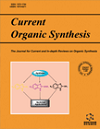- Home
- A-Z Publications
- Current Organic Synthesis
- Previous Issues
- Volume 19, Issue 8, 2022
Current Organic Synthesis - Volume 19, Issue 8, 2022
Volume 19, Issue 8, 2022
-
-
Facile and Environment-friendly Fluorinations using Ionic Liquids
More LessBy Komal JakharSignificant advancement in the preparation of fascinating fluoroorganics is highly desirable in view of their limited natural occurrence and ever-increasing applications in medicinal and material sciences. Ionic liquids act as the most promising green media for a variety of nucleophilic and electrophilic fluorinations in terms of chemoselectivity, reaction yields, reusability, operational simplicity and scalability. The use of these Read More
-
-
-
The Synthesis and Application of Ionic Liquid Functionalized Mesoporous Silica SBA-15 for Organic Synthesis
More LessAuthors: Ghodsi M. Ziarani, Fatemeh Javadi, Fatemeh Mohajer and Alireza BadieiIonic liquid functionalized mesoporous silica compounds present significant advantages in organic synthesis as catalysts. There are various preparation procedures for the synthesis of diverse ionic liquid catalysts, which have different catalytic properties with various roles in organic reactions. Therefore, due to the increment in the usage of mesoporous materials in the industry and numerous pieces of research, in thi Read More
-
-
-
Supported Ionic Liquids and their Applications in Organic Transformations
More LessAuthors: Ambika and Pradeep P. SinghIonic liquids are one of the greener solvents which have emerged as a replacement for toxic and harmful volatile organic solvents. In the past decade, the concept of supported ionic liquids (SILs) has attracted the attention of the scientific community due to their unique chemical and physical properties. SILs can be synthesized by coating a thin layer of IL film onto/into the surface of solid support. They can be classifie Read More
-
-
-
Imidazole Hydrochloride Promoted Synthesis of Nitriles from Aldehydes
More LessAuthors: Yin Wang, Xuetong Wang, Yanwu Li, Xiuyu Zhang, Lingli Li, Tingshu He, Jianyong Yuan and Suqin ShangBackground and Objective: As a key pharmacophore, the cyano group widely exists in a variety of biologically active compounds. Besides, nitriles are also valuable intermediates for many common functional groups. In this current work, a new synthesis strategy was developed to obtain nitriles from aldehydes. Methods: Using commercially available aldehydes as raw materials, and hydroxylamine and hydrochloride as nitrogen s Read More
-
-
-
Mechanochemical Promoted Heterocycles: A Solvent-free Route to Triazole Carbohydrates as Glycogen Phosphorylase Inhibitors
More LessAims: This study aimed to recommend a novel way for the preparation of carbohydrates containing triazole derivatives. Background: Triazoles containing derivatives have numerous biological activities. Ball milling is a fast, modest, green process with massive potential. One of the greatest interesting applications of this technique is in the arena of heterocycles. Objective: Solvent-free click reactions are facilitated via the acti Read More
-
Volumes & issues
-
Volume 22 (2025)
-
Volume 21 (2024)
-
Volume 20 (2023)
-
Volume 19 (2022)
-
Volume 18 (2021)
-
Volume 17 (2020)
-
Volume 16 (2019)
-
Volume 15 (2018)
-
Volume 14 (2017)
-
Volume 13 (2016)
-
Volume 12 (2015)
-
Volume 11 (2014)
-
Volume 10 (2013)
-
Volume 9 (2012)
-
Volume 8 (2011)
-
Volume 7 (2010)
-
Volume 6 (2009)
-
Volume 5 (2008)
-
Volume 4 (2007)
-
Volume 3 (2006)
-
Volume 2 (2005)
-
Volume 1 (2004)
Most Read This Month
Article
content/journals/cos
Journal
10
5
false
en


